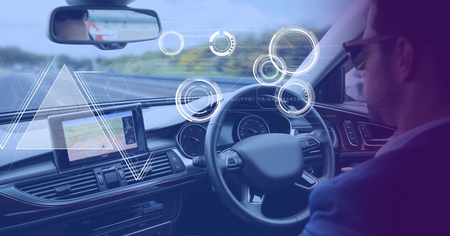Introduction to Connected Infotainment Systems
Over the past decade, American vehicles have undergone a remarkable transformation, moving beyond simple dashboards and basic radio units to sophisticated connected infotainment systems. Today’s cars aren’t just machines that get you from point A to point B—they’re digital hubs on wheels, seamlessly blending navigation, entertainment, and communication. Whether you’re streaming your favorite playlist through Apple CarPlay or getting real-time traffic updates via embedded LTE, the modern in-car experience is built around connectivity. This integration goes far beyond convenience; it changes how drivers and passengers interact with their vehicles and the outside world. Automakers across the U.S. are now prioritizing these systems as a selling point, equipping new models with touchscreens, voice assistants, over-the-air software updates, and even app stores. As these infotainment platforms become more advanced and interconnected—with everything from smartphones to smart home devices—the attack surface for potential cybersecurity threats grows wider. In this evolving landscape, understanding both the promise and the risks of connected infotainment is essential for anyone behind the wheel.
2. Cybersecurity Threat Landscape
When it comes to the modern American driving experience, connected infotainment systems are at the heart of in-car convenience and entertainment. However, this connectivity also opens up new doors for cybercriminals. Unlike traditional vehicle systems, infotainment units are directly linked to smartphones, Wi-Fi hotspots, GPS navigation, cloud accounts, and even payment apps—creating a complex web of potential vulnerabilities.
Real-World Threats in the US Market
Several notable incidents have highlighted how these systems can be exploited. For example, ethical hackers have demonstrated remote control over critical vehicle functions by breaching infotainment software—a chilling reminder seen with the 2015 Jeep Cherokee hack in St. Louis, where researchers remotely manipulated steering and braking through a vulnerability in the Uconnect system. More recently, US automakers have been on high alert after reports of ransomware attacks targeting customer data stored in infotainment units.
Main Cybersecurity Threats
| Threat Type | Description | US Example |
|---|---|---|
| Remote Code Execution | Hackers gain access to vehicle controls via infotainment vulnerabilities. | 2015 Jeep Cherokee (Uconnect) |
| User Data Theft | Theft of personal info synced from mobile devices or cloud accounts. | Tesla Model S data scraping (San Francisco, 2021) |
| Malware Injections | Malicious apps or USB drives used to infect the system. | Aftermarket Android head units (LA car shows) |
| Denial-of-Service (DoS) | System freeze or crash via network overload attacks. | Fleet vehicles targeted by DoS attacks (New York delivery services) |
The Expanding Attack Surface
The integration of voice assistants like Amazon Alexa and Apple CarPlay further extends the attack surface. As Americans increasingly rely on digital wallets and voice-activated purchases from their dashboards, each new feature is another potential entry point for hackers. The challenge lies not just in protecting vehicles from current threats but also anticipating how evolving tech trends might be exploited by future attackers.

3. Privacy and Data Protection Challenges
When you slide behind the wheel of a modern vehicle, it’s easy to take for granted how seamlessly your smartphone syncs with the infotainment system or how intuitively your favorite apps pop up on the dashboard. However, the convenience of connected infotainment platforms comes with significant privacy concerns, especially as these systems gather mountains of personal data—from GPS locations and driving habits to voice commands and even contacts. For drivers in the United States, the challenge lies in safeguarding this sensitive information in a landscape where digital privacy is an evolving battleground.
Understanding What’s at Stake
Connected infotainment systems are data powerhouses, constantly collecting and transmitting information to manufacturers, service providers, and sometimes third-party advertisers. This data can include everything from your daily commute patterns to entertainment preferences and even biometric identifiers if your car supports voice or facial recognition. The risk? If not properly protected, this treasure trove can be exposed through cyberattacks or unauthorized access, leading to identity theft, stalking, or unwanted surveillance.
American Privacy Standards: A Patchwork Approach
The U.S. doesn’t have a single, comprehensive federal privacy law like the EU’s GDPR. Instead, American drivers rely on a patchwork of state-level regulations—California’s CCPA being the most prominent—that grant consumers certain rights over their personal data. Automakers and tech companies operating infotainment platforms must navigate these varying rules, ensuring they obtain proper consent, provide transparency about what data is collected, and offer options for users to opt out or delete their information. Yet, many drivers remain unaware of just how much data their vehicles are sharing behind the scenes.
The Road Ahead: Building Trust Through Transparency
To address these challenges, automakers need to invest in robust cybersecurity measures and prioritize clear communication with drivers about privacy practices. Transparent policies—delivered in plain language at the point of sale or during software updates—are crucial for building trust. Ultimately, protecting personal data isn’t just a technical challenge; it’s about respecting driver autonomy and creating a safer digital environment every time you hit the road.
4. Impacts on Driving Experience and Safety
Connected infotainment systems promise seamless navigation, entertainment, and hands-free communication—essentials for the modern American driver who spends a significant amount of time on the road. However, these conveniences come with cybersecurity risks that can directly impact both driving experience and safety. For drivers in the US, where long commutes, family road trips, and even rideshare services are deeply woven into daily life, any threat to vehicle control or personal data can quickly erode confidence behind the wheel.
Cybersecurity Vulnerabilities: A Threat to Trust and Control
Americans value their sense of control when driving. The idea that a hacker could remotely manipulate a car’s infotainment system—or even access steering and braking functions via networked components—introduces uncertainty that challenges this core expectation. High-profile incidents where vehicles were hacked remotely have made headlines and sparked public concern. This anxiety isn’t just theoretical; it influences how drivers interact with technology and how much they trust advanced features like voice assistants, over-the-air updates, or wireless smartphone integration.
Impact on Road Safety
The stakes are high when cybersecurity lapses occur in connected vehicles. Infotainment systems compromised by malware or unauthorized access can distract drivers at critical moments or cause system failures that disrupt navigation, emergency calling (eCall), or essential vehicle alerts. In the context of US highways—often busy, fast-moving, and unforgiving of mistakes—the margin for error is slim.
Common Cybersecurity Risks and Their Effects on US Drivers
| Vulnerability | Potential Impact on Driving Experience | Safety Implications |
|---|---|---|
| System Takeover via Wireless Access | Loss of infotainment control; unexpected behavior of displays and audio | Distraction; possible loss of vehicle control in extreme cases |
| GPS Spoofing | Misdirected routes; unreliable navigation assistance | Increased risk of accidents or getting lost, especially in unfamiliar areas |
| Data Breaches (Personal Info Theft) | Anxiety about privacy; reduced willingness to use connected features | No direct physical danger but undermines trust in vehicle safety overall |
| Denial-of-Service Attacks on Critical Systems | Delayed response from emergency features; frozen touchscreens | Impaired access to emergency help; delayed hazard warnings |
Cultural Insights: The American Perspective on Tech and Safety
The American approach to driving places high value on independence, reliability, and family safety. Any factor that threatens these values—such as a perceived vulnerability in one’s own vehicle—can drive consumer skepticism toward new automotive technologies. Manufacturers must not only engineer robust security but also communicate clearly about protections in place to reassure drivers who are keenly aware of both digital threats and their real-world consequences.
5. Current Solutions and Best Practices
As connected infotainment systems become more widespread in American vehicles, automakers and tech companies are ramping up their efforts to protect drivers from cyber threats. Let’s break down the real-world strategies and technologies in play across the US automotive sector.
Defense-in-Depth: Layered Security Approach
Much like a well-designed racetrack with multiple barriers, modern cybersecurity employs a “defense-in-depth” strategy. Automakers layer security controls throughout the vehicle’s electronic architecture—securing everything from infotainment head units to backend telematics. This means even if one barrier is breached, there are additional safeguards in place, making it tougher for hackers to reach critical systems.
Encryption and Secure Communication
Just as you’d never leave your car unlocked, manufacturers are encrypting data transmitted between infotainment systems and external networks. Advanced protocols like TLS (Transport Layer Security) ensure that information such as navigation routes, streaming content, and over-the-air updates remain confidential and tamper-proof.
Regular Software Updates & Patch Management
In the same way drivers schedule oil changes, routine software updates have become essential maintenance for infotainment security. American automakers deploy over-the-air (OTA) updates to patch vulnerabilities quickly, keeping vehicles protected against evolving cyber risks without requiring owners to visit the dealership.
Intrusion Detection Systems (IDS)
Much like an alarm system in your garage, IDS monitors network traffic within the vehicle for suspicious activity. When anomalies are detected—such as unauthorized access attempts—these systems can isolate affected modules or alert drivers and manufacturers before any real damage occurs.
Industry Collaboration & Standardization
The American auto industry understands that cybersecurity is a team sport. Organizations like Auto-ISAC (Automotive Information Sharing & Analysis Center) allow manufacturers to share intelligence on emerging threats and best practices. Meanwhile, compliance with standards such as ISO/SAE 21434 ensures that cybersecurity is baked into every stage of vehicle development—from design to deployment.
Driver Awareness & Training
Finally, American drivers themselves play a role in defense. Manufacturers provide guidance on safe digital habits—like using strong passwords for connected services and being wary of third-party apps—to help keep infotainment systems secure long after they’ve left the factory floor.
6. Future Outlook and Legislative Framework
Looking ahead, the road for cybersecurity in connected infotainment systems is both promising and complex. As cars continue to evolve into rolling data centers, the demand for robust digital defenses is accelerating at breakneck speed. Automakers and tech companies are expected to leverage advances in artificial intelligence and machine learning to predict, detect, and neutralize cyber threats in real time—making vehicle networks smarter and more adaptive than ever before.
Anticipated Advances in Cybersecurity
We can expect to see next-generation encryption protocols, multi-factor authentication tailored for automotive environments, and continuous over-the-air security updates becoming industry standards. Zero-trust architectures—where every device, user, and application must prove its legitimacy before accessing the car’s network—are likely to become the backbone of future infotainment system protection. Moreover, collaborative threat-sharing platforms among automakers could enable rapid identification and mitigation of new vulnerabilities across the entire industry.
The Evolving Legal Landscape
On the legislative front, the United States is moving toward a more unified approach to automotive cybersecurity. While current regulations are often fragmented and reactive, federal agencies like NHTSA (National Highway Traffic Safety Administration) are working alongside Congress to establish comprehensive frameworks that set minimum security requirements for all connected vehicles sold on American roads. We’re seeing proposals that would mandate vulnerability disclosure programs, standardized incident reporting, and even third-party audits of vehicle software. These evolving laws aim not only to protect drivers but also to hold manufacturers accountable for lapses in cyber defense.
Industry Collaboration and Consumer Trust
The future will also depend on how well automakers collaborate with regulators, cybersecurity experts, and each other. Building consumer trust is paramount; after all, drivers want confidence that their personal data—and their safety—are safeguarded every mile of the journey. The integration of transparent privacy policies, user-friendly security features, and ongoing education campaigns will play a pivotal role in shaping public perception as technology races ahead.
Ultimately, the path forward requires a blend of cutting-edge innovation and strong governance. By staying ahead of cybercriminals and aligning with a proactive legislative framework, the automotive industry can ensure that tomorrow’s infotainment systems deliver both unparalleled connectivity and peace of mind behind the wheel.


